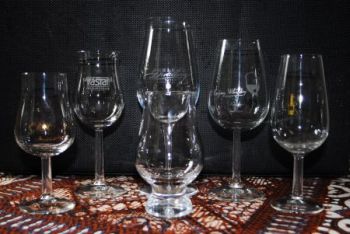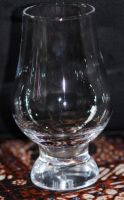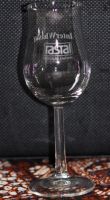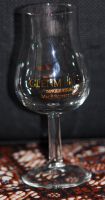|
Which whisky
glass do I recommend?
| |


Slàinte Mhath
Keith
Wood
|
|
This is a question
which crops up time and again;
Which is the best glass for whisky?
In this feature I
shall offer my own opinions which are based upon extensive
testing completed during
two tastings
and also during some evening dramming sessions, specifically
with this question in mind. But firstly, I would like to address
two related points.
1. Ice in whisky;
I am firmly of the
belief that ice should not be put into whisky. I believe it
kills, freezes or just masks the delicate flavours which one
should savour and not destroy.
2. How to hold the glass;
This is a more
difficult question as it is really one of temperature. Whisky
should be savoured at normal room temperature, which for me is
around 20-23°C, so if I take a bottle from a colder place, such
as a cellar which is often more like 8-12°C, then it either has
to stand for quite some time to acclimatise, or it requires a
little hand-warming to help it reach room temperature. If the
whisky is at room temperature, then I prefer to hold the glass
by the base or lower stem, keeping my hands away from the actual
bowl containing the liquid.
|
|
| |
I maintain that
whisky should, or does, tantalise all the senses, from the
colour of a particular expression, the mouth-feel, the unique
flavours on the palate, but possibly most important of all, the
aromas released when nosing the whisky. Our taste buds, the
receptors in the tongue which detect tastes can identify five
different sensations; sweet, sour, salt, bitter and the fifth
being unami. Our noses are home to the olfactory receptors, of
which we have literally hundreds, so I would argue that we are
able to detect far more from these than from our palates. In
this way I truly believe that the most important part of
savouring any whisky is the careful nosing of it. A part which
should not be rushed and which will give great awareness and
pleasure when done correctly.
To this end, the
glass is extremely important as each has its own unique style
and helps to express the whisky in very different ways to the
nose. Even the inclusion of a small lip at the top of the glass
can make a distinct difference, so in this study I have taken
the five most commonly-used nosing glasses, plus one other which
was not originally designed for whisky and subjected them to a
head to head comparison.
|
|
| |
The
contenders & the
analysis |
|
| |
Glencairn
 |
|
Feel:
This is the smallest of the glasses but the one which possibly
sits best in the hand. It is also the most sturdy as it has a
solid wide base without any stem.
Light/Floral whisky: With an old 1980's bottling of Milton Duff
Glenlivet which is an extremely floral whisky the Glencairn
proved to be a very good glass, allowing the complex mix of
aromas to gently reach the nose in a pleasant bouquet. However,
this glass did take a few minutes before delivering the best
results.
Heavily Sherried whisky: Once again, this glass performed well with
a 'peak' of aromas after a few minutes of acclimatisation.
Peated
whisky:
The Glencairn performed very well with the PC7 which I used
for the peat-test. It gave slightly quicker results, peaking
after 3-4 minutes, but then fading away after 8-10 minutes. |
|
| |
Bugatti
Kelch
 |
|
Feel:
This is probably the most common of the nosing glasses and is
used at most whisky festivals I've attended. It is
comfortable in the hand if warming is required and has a long
stem allowing it to be held either by the base or the lower stem.
Light/Floral whisky: With the old 1980's bottling of Milton Duff
Glenlivet this glass offered only a rather weak nose which never
really matched the results of the other glasses, even after
allowing 8-10 minutes of acclimatisation.
Heavily Sherried whisky: The Glenallachie sherry cask is a strong
whisky with rich sherry notes which never quite reached the
heights required in this glass. Once again, time didn't help.
Peated
whisky:
This performed better with the PC7, offering most of the
peaty notes quite quickly and allowing them to stay for some
length of time. |
|
| |
Spiegelau
 |
|
Feel:
The Spiegelau is by far the largest glass of this group and sits
well in the hand allowing holding by bowl, stem or base.
Light/Floral whisky: The delicate and complex aromas are almost
immediately eased to the nose in their full glory. This glass
performs quicker and more intensely than any of the others. But after
some minutes it does seem to fade, where others improve.
Heavily Sherried whisky: The wonders of this dram were once again
immediate, but again faded slightly after some minutes.
Peated
whisky:
Again the full extent and complexity of aromas were
immediate, but almost totally lost after 5-6 minutes. |
|
| |
Classic
Malt
 |
|
Feel:
To many people this is the classic glass. A simple but
effective shape, good in the hand and comfortable.
Light/Floral whisky: The complex aromas of the Milton Duff
Glenlivet were not as immediate as the Speigelau, but they did
last much longer.
Heavily Sherried whisky: The aromas with the Glenallachie were
again not as immedaite, but after a few minutes they were far
more concentrated and an absolute delight in this glass.
Peated
whisky:
Once again the PC7 was a delight in the Classic Malt glass
and the peaty aromas improved with a little time, but didn't
fade away. |
|
| |
Sherry
Glass
 |
|
Feel:
Quite small, funnelled and delicate.
Light/Floral whisky: A strange sensation, the aromas are there, but
seem to be concentrated, not in strength, but in the spread
presented to the nose. Obviously the narrow shape of the glass
creates this sensation.
Heavily Sherried whisky: Once again the aromas are mainly present,
but almost funnelled directly to the nose in a concentrated
burst. This does improve slightly after some minutes.
Peated
whisky:
Pretty much the same effect again, but once again, I do have
to say that the aromas were there and not in any way hidden. |
|
| |
Short-stemmed
 |
|
Feel:
I don't know the official name for this glass, but it is a
short-stemmed nosing glass which I have most often seen bearing
the brand names of Glenmorangie or Ardbeg. In fact this is a
Glenmorangie one. It seems quite stable due to the short stem,
but it just doesn't sit quite right in the hand. It kind of
feels slightly top-heavy.
Light/Floral whisky: A better spread of aromas than the Bugatti, but
still quite weak compared to the others. The aromas fade
severely over 5-8 minutes.
Heavily Sherried whisky: A much better performance with the
Glenallachie as the aromas work very well in this style of glass,
but they again fade after some minutes.
Peated
whisky:
A couple of minutes to work at best affect, then a peak for
2-3 minutes and fading thereafter. |
|
| |
 |
The
Result |
 |
|
| |
 |
Classic
Malt |
A great
glass which performed extremely well overall, especially in
holding the aromas for a length of time. |
|
| |
 |
Glencairn |
Another
fantastic glass which possibly has the best 'feel' of all, with
only a slightly inferior performance to the Classic. |
|
| |
 |
Spiegelau |
Unequalled within the first few minutes of nosing, especially on
the lighter more complex whiskies, but over time the aromas do
fade drastically. |
|
| |
The
scoring |
With 6
different glasses the scoring awarded 6 points to the best in a
category, then scaled down to 1 point for the worst. There were
7 categories including Feel, Light/Floral (whisky), Heavily
sherried and Peated. The other three categories were for the same
three whisky types, but allowing for passing of time to see if
the performance changed after some minutes. So, there were 7
categories, each awarding up to 6 points, meaning a theoretical
maximum score of 42 points could be possible. |
|
| |
|
|
|
Feel |
Light |
Light -
time |
Sherried |
Sherried
- time |
Peat |
Peat -
time |
Total |
|
| |
|
|
Classic Malt |
5 |
5 |
5 |
5 |
6 |
4.5 |
5 |
35.5 |
|
| |
|
|
Glencairn |
6 |
4 |
6 |
3 |
5 |
4.5 |
6 |
34.5 |
|
| |
|
|
Spiegelau |
4 |
6 |
4 |
6 |
3 |
6 |
4 |
33 |
|
| |
|
|
Short-stemmed |
2 |
3 |
3 |
4 |
2 |
2 |
2 |
18 |
|
| |
|
|
Sherry |
1 |
2 |
2 |
2 |
4 |
3 |
3 |
17 |
|
| |
|
|
Bugatti |
3 |
1 |
1 |
1 |
1 |
1 |
1 |
9 |
|
© Copyright
2009-2020 by Keith Wood - All rights reserved - Whisky-Emporium |
 |
